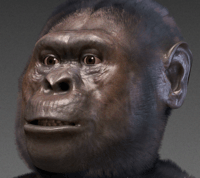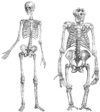Archaic humans
.jpg)
A number of varieties of Homo are grouped into the broad category of archaic humans in the period contemporary and predating the emergence of the earliest anatomically modern humans (Homo sapiens) over 315 ka. The term typically includes Homo neanderthalensis (430+–38ka),[1] Denisovans, Homo rhodesiensis (300ka–125ka), Homo heidelbergensis (600ka–200ka), Homo antecessor.
There is no universal consensus on this terminology, and varieties of "archaic humans" are included under the binomial name of either Homo sapiens or Homo erectus by some authors.
Archaic humans had a brain size averaging 1,200 to 1,400 cubic centimeters, which overlaps with the range of modern humans. Archaics are distinguished from anatomically modern humans by having a thick skull, prominent supraorbital ridges (brow ridges) and the lack of a prominent chin.[2][3]
Anatomically modern humans appear from over 315,000 years ago (Jebel Irhoud) and after 70,000 years ago (see Toba catastrophe theory), gradually supplanting the "archaic" human varieties. Non-modern varieties of Homo are certain to have survived until after 30,000 years ago, and perhaps until as recently as 10,000 years ago. Which of these, if any, are included under the term "archaic human" is a matter of definition and varies among authors. Nonetheless, according to recent genetic studies, modern humans may have bred with "at least two groups" of ancient humans: Neanderthals and Denisovans.[4] Other studies have cast doubt on admixture being the source of the shared genetic markers between archaic and modern humans, pointing to an ancestral origin of the traits originating 500,000–800,000 years ago.[5][6][7]
Another group may also have been extant as recently as 11,500 years ago, the Red Deer Cave people of China.[8] Chris Stringer of the Natural History Museum in London has suggested that these people could be a result of mating between Denisovans and modern humans.[9] Other scientists remain skeptical, suggesting that the unique features are within the variations expected for modern human populations.[10]
Terminology and definition
The category archaic human lacks a single, agreed upon definition.[2] According to one definition, Homo sapiens is a single species comprising several subspecies that include the archaics and modern humans. Under this definition, modern humans are referred to as Homo sapiens sapiens and archaics are also designated with the prefix "Homo sapiens". For example, the Neanderthals are Homo sapiens neanderthalensis, and Homo heidelbergensis is Homo sapiens heidelbergensis. Other taxonomists prefer not to consider archaics and modern humans as a single species but as several different species. In this case the standard taxonomy is used, i.e. Homo rhodesiensis, or Homo neanderthalensis.[2]
The evolutionary dividing lines that separate modern humans from archaic humans and archaic humans from Homo erectus are unclear. The earliest known fossils of anatomically modern humans such as the Omo remains from 195,000 years ago, Homo sapiens idaltu from 160,000 years ago, and Qafzeh remains from 90,000 years ago are recognizably modern humans. However, these early modern humans do possess a number of archaic traits, such as moderate, but not prominent, brow ridges.
Brain size expansion

The emergence of archaic humans is sometimes used as an example of punctuated equilibrium.[11] This occurs when a species undergoes significant biological evolution within a relatively short period. Subsequently, the species undergoes very little change for long periods until the next punctuation. The brain size of archaic humans expanded significantly from 900 cm3 (55 cu in) in erectus to 1,300 cm3 (79 cu in). Since the peak of human brain size during the archaics, it has begun to decline.[12]
Origin of language
Robin Dunbar has argued that archaic humans were the first to use language. Based on his analysis of the relationship between brain size and hominin group size, he concluded that because archaic humans had large brains, they must have lived in groups of over 120 individuals. Dunbar argues that it was not possible for hominins to live in such large groups without using language, otherwise there could be no group cohesion and the group would disintegrate. By comparison, chimpanzees live in smaller groups of up to 50 individuals.[13][14]
Fossils
- Atapuerca Mountains, Sima de los Huesos
- Saldanha Man
- Altamura Man
- Kabwe Skull
- Steinheim Skull
- Ndutu cranium
See also
References
- ↑ Hublin, J. J. (2009). "The origin of Neandertals". Proceedings of the National Academy of Sciences. 106 (38): 16022–7. Bibcode:2009PNAS..10616022H. doi:10.1073/pnas.0904119106. JSTOR 40485013. PMC 2752594. PMID 19805257.
- 1 2 3 Dawkins (2005). "Archaic homo sapiens". The Ancestor's Tale. Boston: Mariner. ISBN 0-618-61916-X.
- ↑ Barker, Graeme (1 January 1999). "Companion Encyclopedia of Archaeology". Routledge – via Google Books.
- ↑ Mitchell, Alanna (January 30, 2012). "DNA Turning Human Story Into a Tell-All". NY Times. Retrieved January 31, 2012.
- ↑ Telegraph Reporters (14 August 2012). "Neanderthals did not interbreed with humans, scientists find". Telegraph.co.uk.
- ↑ Association, Press (4 February 2013). "Neanderthals 'unlikely to have interbred with human ancestors'" – via The Guardian.
- ↑ Lowery, Robert K.; Uribe, Gabriel; Jimenez, Eric B.; Weiss, Mark A.; Herrera, Kristian J.; Regueiro, Maria; Herrera, Rene J. (1 November 2013). "Neanderthal and Denisova genetic affinities with contemporary humans: Introgression versus common ancestral polymorphisms". Gene. 530 (1): 83–94. doi:10.1016/j.gene.2013.06.005 – via ScienceDirect.
- ↑ Amos, Jonathan (March 14, 2012). "Human fossils hint at new species". BBC. Retrieved March 14, 2012.
- ↑ Barras, Colin (2012-03-14). "Chinese human fossils unlike any known species". New Scientist. Retrieved 2012-03-15.
- ↑ James Owen (2012-03-14). "Cave Fossil Find: New Human Species or "Nothing Extraordinary"?". National Geographic News.
- ↑ Huyssteen, Van; Huyssteen, Wentzel Van (12 April 2006). "Alone in the World?". Wm. B. Eerdmans Publishing – via Google Books.
- ↑ Zyga, Lisa (15 March 2010). "Cro Magnon skull shows that our brains have shrunk". phys.org. Retrieved 14 June 2017.
- ↑ CO-EVOLUTION OF NEOCORTEX SIZE, GROUP SIZE AND LANGUAGE IN HUMANS Archived June 26, 2009, at the Wayback Machine.
- ↑ Dunbar (1993). Grooming, Gossip, and the Evolution of Language. Harvard University Press. ISBN 978-0-674-36336-6.



